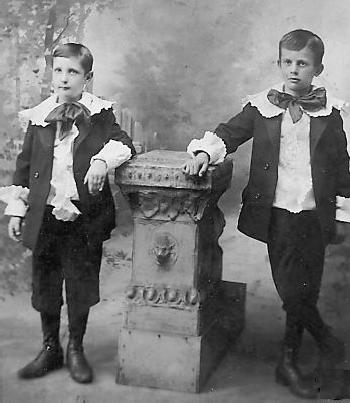
American Boys Clothes: Social Class

Figure 1.--These unidentified Chicago boys, presumably brothers, had their portrait taken at Whipple's Studio. The portrait is undated, but was probably taken in the 1890s. They wear regular suits with Fauntleroy blouse. Social class was a major factor in the Fauntlroy craze. Initially itwas a way for the newly rich indistrial class to show off their wealth. The style was soon copied by the middle class which is probably why these boys are wearing Fauntleroy blouses.
|
|
Social class until recently had a major impact on how American children dressed. A major factor here is that in the 19th and eveb early-20th century many children worked rather than going to school. Children from working-class families were much less likely to attend school. States varied as to child labor and compulsory school attendance laws. American had a more advanced public education ystem than much of Europe, but still many children did not attend scool or ty in school very long. This significantly affected how they were dressed. Boys who worked in mines and factories might wear overalls for work as did their fathers. Working children in cities sych as newsies and delivery boys dressed more like other children, wearing suits, often knee pants suits which was a popular style at the turn-of-the 20th century. Suits seem rather popular to us today, but were commonly worn at the time. Many boys did not have changes of clothes to wear. These often were part time jobs and many of these boys also attended school. Commonly once boys kleft schol they were more likely to wear long pants suits. There were also uniforms for boys involved with the public (telegram delivery boys or hotel bellhops). Children from more affluent families wore clothes associated with childhood. Then between the groups of children there seems to be further class division. Wealthiest children appeared to wear more juvenile clothes, a least when young. Q complicating factor here is that in the 19th and early 20th century, wealthy people set fashion trends. When you look at catalogs such as Bella Hess, National, Sears and Wards, the children clothes appear to be very juvenile for younger ages and less juvenile and more long pants as the child reaches age 6 or so. For catalogs such as Best & Company and Franklin Simon which appears to cater to a wealthier clientele, Eton suits were available for older children as were short pants suits and there were more dresses for toddlers that stated for boys or boyish definitely to age 3 and possibly age 6. This perception matches the films when we compare wealthier children's dress to poorer children in the movies etc. After World War II there were major changes as a result of widening affluence. Children in rural areas no longer dressed differently than city boys. As the working-class entered the middle class we no longer see major differences social class differences in clothing styles. A subsequent shift was that we befin to see a fashion influence from the low-incme people in te big cities that appealed to some middle-class teenagers in the suburbs. This occurred along with a similar trend in music.
HBC

Navigate the Boys' Historical Clothing Web Site:
[Return to the Main U.S. page]
[Introduction]
[Activities]
[Biographies]
[Chronology]
[Clothing styles]
[Countries]
[Bibliographies]
[Contributions]
[Essays]
[FAQs]
[Glossaries]
[Images]
[Links]
[Registration]
[Tools]
[Boys' Clothing Home]
Navigate the Boys' Historical Clothing Web Site casual pages:
[Return to the Main casual page]
[Camp shorts]
[Clam diggers]
[Cord shorts]
[Jump suits]
[Koveralls]
[Lederhosen]
[Pinafore]
[Shortalls]
[Smocks]
[Soccer shorts]
Navigate the Historic Boys' Clothing Web chronological pages:
[The 1840s]
[The 1870s]
[The 1900s]
[The 1930s]
[The 1940s]
[The 1950s]
[The 1960s]
[The 1970s]
[The 1980s]
[The 1990s]
[The 2000s]
Created: 8:20 PM 1/4/2009
Last updated: 8:20 PM 1/4/2009



